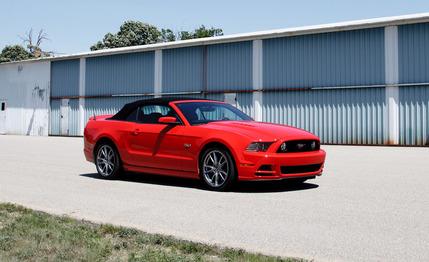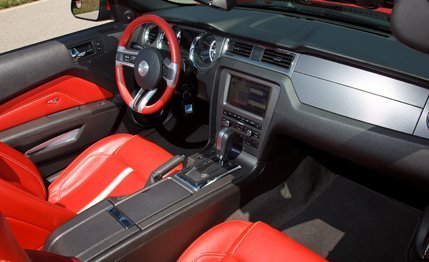
 Instrumented Test
Instrumented Test


The folks at Chevrolet think otherwise, but in addition to baseball, hot dogs, and apple pie, few things ooze Americana more than does a Ford Mustang convertible, especially one propelled by a V-8 engine. That was true in April 1964, when Ford unveiled the original at the New York World’s Fair, and it’s true today, despite some hiccups here and there.
And if the sum of the improvements isn’t quite equal to the pace of contemporary technology in certain areas, so what? Just drop the top, light it up, and listen to that eight-cylinder rhythm, a baritone concerto that’s essentially unique to this engine type—part mellow, part menace. The aural element is generated here by the latest 5.0-liter DOHC 32-valve V-8, amplified by 420 hp at 6500 rpm and 390 lb-ft of torque at 4250.
That’s a little more than the 2012 5.0-liter had—8 hp, to be specific—thanks primarily to the use of piston coatings pioneered in the Boss 302. What’s the increase worth? We can’t really say. The distinction is too subtle to bother quantifying at the track. But we can say that the 2013 GT convertible gets out of the starting blocks and down the street in a hurry.
Stoplight Warrior
Equipped with a six-speed automatic transmission—a $1195 option—our 5.0 GT test car sprinted to 60 mph in 4.8 seconds, to 100 mph in 11.3, and covered the quarter-mile in 13.3 seconds at 109 mph. That’s pretty brisk and stacks up well versus the Mustang’s primary rival. A 2011 Camaro SS convertible we tested turned in almost identical times, accomplishing 60 in 4.9 seconds, 100 in 11.2, and the 440-yard dash in 13.4 at 109 mph. And that particular Camaro was equipped with a manual transmission.
Would the GT sprint a smidge quicker with a manual transmission? Possibly. The six-speed self-shifter does a good job of managing the 5.0’s thrust, but its manual function, operated by a fairly useless rocker switch on the side of the shift lever, is a little soft and isn’t as satisfying to use as a set of paddle shifters. The Mustang engineers say the current architecture makes the installation of paddles prohibitively expensive. boasting an independent rear suspension.


Subdermal Shortcomings
Reservations about the automatic notwithstanding, the GT is a fine conveyance in everyday traffic, the rumble of its tailpipes conjuring memories of cruise nights when first-gen Mustang convertibles turned heads on Detroit’s Woodward Avenue. But there are better Mustangs if your driving preferences run to twisty back roads, track days, and/or autocross. The sublime Boss 302 comes to mind.
As a coupe, the Mustang’s chassis rigidity is stout. But the absence of a steel top yields a body shell that’s prone to quivers and hints of cowl shake on even moderately bumpy pavement. This phenomenon was true of a 2011 version we tested, and although it wasn’t pronounced during our earlier preview drive of the 2013, the shakes manifest themselves all too tangibly on Michigan back roads.